Konica Minolta Dynax Maxxum 7DAt long last, Minolta SLR owners have a *very* worthy body to use with their lens collections!<<Maxxum 7D Sample Images :(Previous) | (Next): Print-Friendly Review Version>> Maxxum 7D Imatest ResultsReview First Posted: 11/27/2004, Updated: 02/01/2005 |
Detailed analysis of the Konica Minolta Maxxum 7D images, from Imatest(tm)
I've recently begun using Norman Koren's excellent "Imatest" analysis program for quantitative, thoroughly objective analysis of digicam test images. I highly commend it to our technically-oriented readers, as it's far and away the best, most comprehensive analysis program I've found to date. (And with an introductory price of only $59, it's hard to beat.)
My comments below are just brief observations of what I see in the Imatest results. A full discussion of all the data Imatest produces is really beyond the scope of this review: Visit the Imatest web site for a full discussion of what the program measures, how it performs its computations, and how to interpret its output.
Here's some of the results produced by Imatest for the Konica Minolta Maxxum
7D:
Color Accuracy
Overall, the Konica Minolta Maxxum 7D has very good to excellent hue accuracy
in its default color mode. Like most digital cameras, it tends to oversaturate
reds, somewhat the 7D more than many. In other parts of the spectrum it's
quite restrained, with relatively small amounts of over- and under-saturation.
(Slight oversaturation of blues and some greens, slight undersaturation of
bright yellows, slight hue shifts of cyans toward blues.) On average, color
saturation of swatches on the MacBeth ColorChecker(tm) chart are 109.5% of
their ideal values. (An average oversaturation of 9.5%, but the majority of
this results from its oversaturation of bright reds.) Average "delta-E"
color error is 4.95, better than most competing models.
Color Analysis
These images show the color behavior of the Konica Minolta Maxxum 7D more directly.
In each color swatch, the outer perimeter shows the color as actually captured
by the camera, the inner square shows the color after correcting for the luminance
of the photographed chart (as determined by a 2nd-order curve fit to the values
of the gray swatches), and the small rectangle inside the inner square shows
what the color should actually be, based on perfect rendering to the sRGB color
spacer. From this plot, we can see that while the 7D actually matches most colors
fairly closely, the most apparent deviation being in brightness variations more
so than the color values themselves.
Gray Patch Tone and Noise Analysis
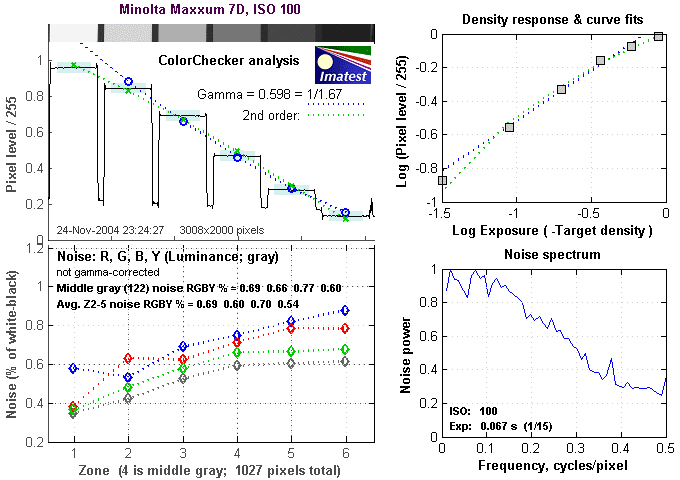
There's a lot in this particular graph, a lot more than I have room to go into
here. Bottom line, the Maxxum 7D's noise levels are about average at ISO 100,
and its noise patterns have a fair bit of higher-frequency content (seen in
the way the lump on the left side of the frequency graph extends so far to the
right). This produces noise with a very fine-grained character, that detracts
much less from the image quality than that of many competing models.
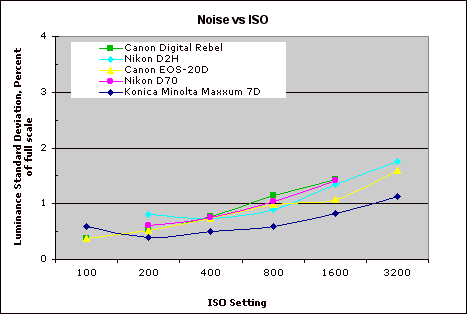
This chart compares the Konica Minolta Maxxum 7D's noise performance over a
range of ISOs against that of competing cameras. As you can see, the 7D's absolute
noise levels are lower at ISO levels of 200 and higher than any of the competing
models it's compared with here. What this chart (and others like it, published
by other reviewers) doesn't show is the frequency characteristics of the image
noise, which has a great deal to do with how objectionable it is to the human
eye, not to mention what the camera does to subject detail in its pursuit of
low image noise. In the case of the 7D, its image noise is fairly fine grained,
which helps make it less obtrusive than it would be otherwise. Unfortunately,
at high ISOs, it also trades away quite a bit of subject detail to achieve its
remarkably low noise levels. - I'd personally much prefer to see less
softening of subject detail, even if it would result in higher noise levels.
The chart above shows consolidated results from spatial frequency response
measurements in both the horizontal and vertical axes. The "MTF 50"
numbers tend to correlate best with visual perceptions of sharpness, so those
are what I focus on here. The Maxxum 7D strikes a very good balance between
sharpening and artifacts, giving good amounts of the former, with relatively
little of the latter. As a result the difference between the as-shot and corrected
resolution numbers is fairly modest, with an an average uncorrected resolution
of 1293 Line Widths/Picture Height, rising to just 1327 LW/PH when normalized
to a standard 1-pixel sharpening. Bottom line, the 7D captures very good detail
for its 6-megapixel resolution class, and its default in-camera sharpening setting
does a good job of preserving and displaying it.
For the real techno-geeks, the two plots below show the actual edge response
of the Konica Minolta 7D, for horizontal and vertical edge. Here you can see
the relatively modest boost the 7D's sharpening gives to edges, especially along
the horizontal axis (second figure below).
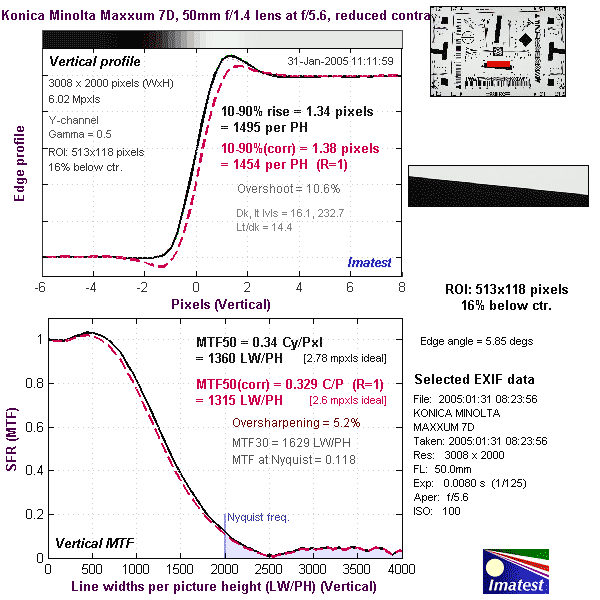
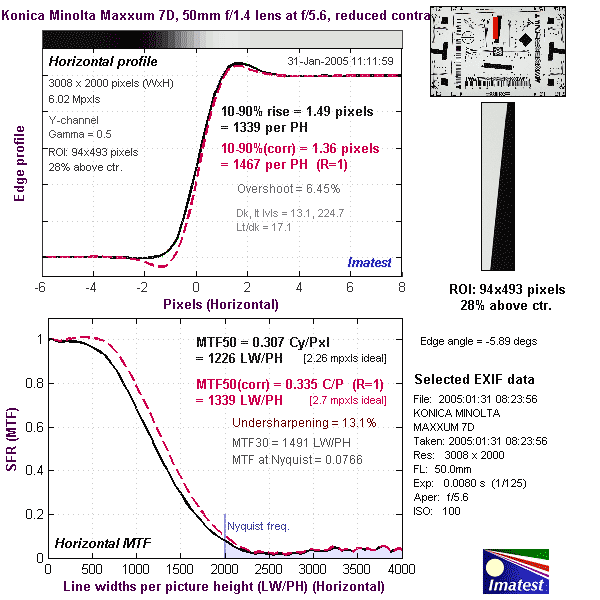
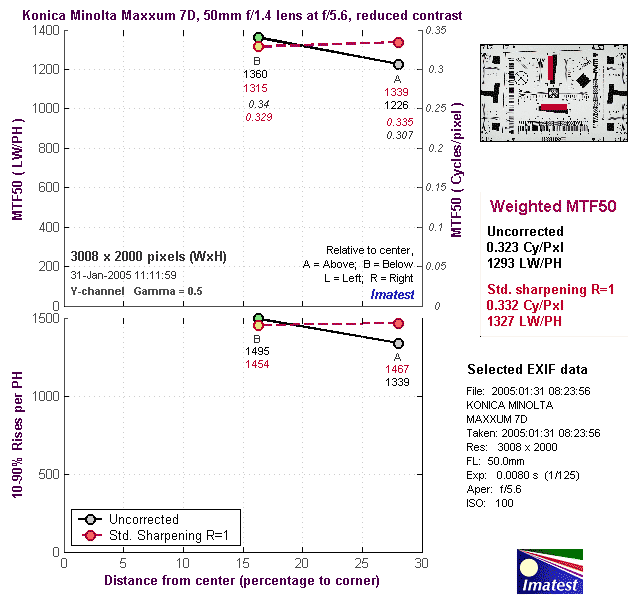

Follow Imaging Resource: